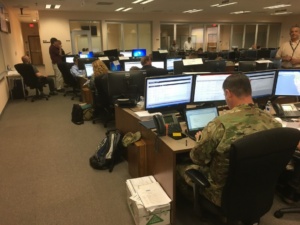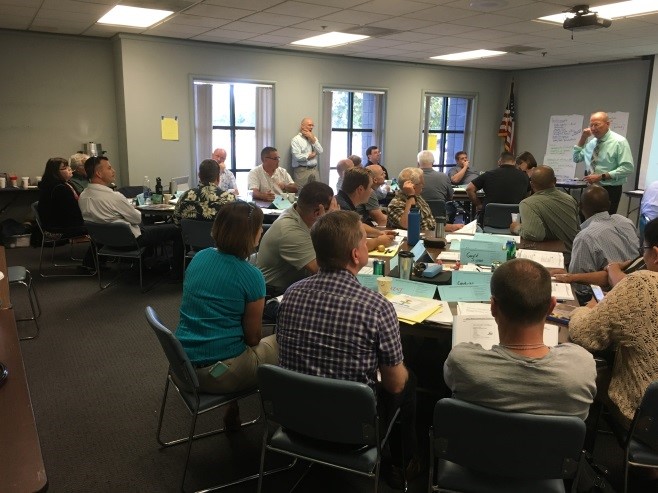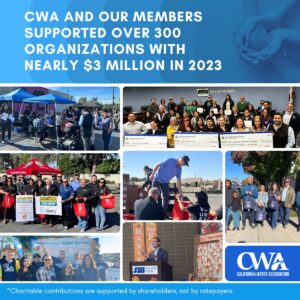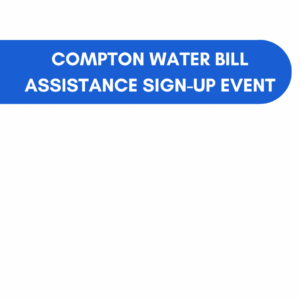Formed in 2013, California Water Association’s (CWA) Safety, Security and Emergency Management Committee (SS&EM) provides a venue for member companies to share best practices to enhance safety, security, safety compliance and emergency preparedness. As Chair of the SS&EM Committee and Manager of Security and Business Resiliency at San Jose Water Company (SJWC), Jim Wollbrinck is well acquainted with the saying, “you never want to exchange business cards during a disaster!” According to Wollbrinck, “Emergency management is all about partnerships where water companies come together to get to know each other, plan with each other and, most importantly, conduct exercises with each other before a crisis occurs to maximize positive outcomes.”
The SS&EM Committee members are working together and with other organizations in the emergency management community, including the California Water/Wastewater Agency Response Network (CalWARN), the Bay Area Emergency and Security Information Collaborative (BAESIC) and the California-Nevada Section of the American Water Works Association’s Security and Emergency Planning Committee.
Additionally, the SS&EM Committee is partnering on several significant projects such as working with BAESIC on field-level incident command training. Pioneered by California Water Service (Cal Water), this training was successfully used to train Cal Water’s field staff and SJWC’s Distribution System field staff in 2016. In conjunction with other trainings developed by East Bay Municipal Utilities District (EBMUD) and Alameda County Water District, the best aspects of the various programs have morphed into a “best-in-class” approach. One valuable benefit of the trainings is a common curriculum that allows utility members to attend one another’s trainings and gain the same level of information.
An example of a successful joint effort is the Water Sector Specific Position (WSSP) led by CalWARN. Initiated in 2008, the collaboration resulted in documentation, which was adopted by the California Office of Emergency Services and used in two emergency activations – the 2010 El Mayor and 2014 South Napa earthquakes. Both activations demonstrated the value of CalWARN and the benefit to CWA in strengthening this partnership. Lessons learned from the earthquakes prompted CWA and CalWARN utilities to revise standard operating procedures and work with the California Specialized Training Institute to update training materials. The goal was to complete the materials and conduct the first of several statewide training sessions on September 1, 2016, in Petaluma, CA in advance of Yellow Command 2016, an emergency management exercise in the Bay Area.
Emergency management also is about communication and coordination. CalWARN and the SS&EM Committee soon will begin using the same application provided by The Alliance for Community Solutions, which will enable CWA to conduct mass notifications to its members for situation status updates, resource requests and utility response coordination. By allowing members to register with both organizations at the same time, CWA and CalWARN will be able to maximize joint planning and activation efforts. Another capability of the application, which is being explored, is the ability for water utilities to connect with other utilities with similar Supervisory Control and Data Application, treatment and disinfection processes in advance of an activation. By working under the WSSP standard operating procedures, CWA members will integrate seamlessly with the greater CalWARN and water-response community.
Emergency management planning, partnering and communicating are important; however, participating in planning exercises also is critical. According to Wollbrinck, “A plan without exercise is nothing more than a doorstop!” Through CWA’s partnership with CalWARN, members have participated in a variety of exercises. Recently, SJWC represented the water sector in Yellow Command 2016. This exercise gave CWA and CalWARN a glimpse into the expected operations at the state level during an emergency. Working closely with agencies, such as the California Energy Commission, California Highway Patrol, California National Guard, California General Services Agency, the Environmental Protection Agency, Federal Emergency Management Agency and the Army Corps of Engineers, CWA gained insights into resources the water sector can leverage through these agencies when needed.
 One of the key items identified during the exercises was the need for emergency fuel supplies after a major disaster, as was the case after Hurricane Katrina and Superstorm Sandy. An earthquake on the north ends of the San Andreas and Hayward Faults would dwarf the impacts of Katrina and Sandy and severely affect the refineries concentrated in the Bay Area. Fuel supplies for the Bay Area, much of the Central Valley and the Reno-Sparks area in Nevada would be diminished. Consequently, CWA members are working on mitigating this problem by developing comprehensive emergency fuel plans and partnerships with key stakeholders, including local and regional emergency managers. The goal is to conduct exercises based on the emergency fuel plans to ensure water utilities can respond to and recover from an earthquake.
One of the key items identified during the exercises was the need for emergency fuel supplies after a major disaster, as was the case after Hurricane Katrina and Superstorm Sandy. An earthquake on the north ends of the San Andreas and Hayward Faults would dwarf the impacts of Katrina and Sandy and severely affect the refineries concentrated in the Bay Area. Fuel supplies for the Bay Area, much of the Central Valley and the Reno-Sparks area in Nevada would be diminished. Consequently, CWA members are working on mitigating this problem by developing comprehensive emergency fuel plans and partnerships with key stakeholders, including local and regional emergency managers. The goal is to conduct exercises based on the emergency fuel plans to ensure water utilities can respond to and recover from an earthquake.
Also in the planning stages is the Haywired Scenario exercise, which will be conducted in spring 2018. This exercise will simulate a 7.05 earthquake on the Hayward Fault to prepare member agencies and critical infrastructure for a large-scale event. Additionally, research conducted by the United States Geological Survey, EBMUD and SJWC has shown the Haywired Scenario would result in thousands of leaks for the two water utilities as well as tens of thousands of leaks region wide. The research indicated repair materials from local and regional distributors would not meet the demands to recover from the earthquake. Planning is underway to identify solutions to this potentially massive problem.





